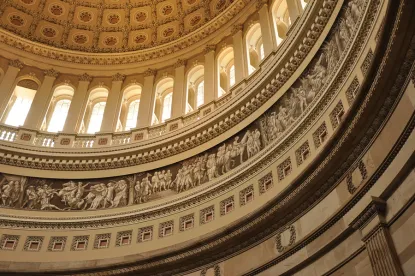On Jan. 1, 2021, the U.S. Senate joined the House in voting to override President Trump’s veto of the National Defense Authorization Act of 2021 (NDAA), which includes several new anti-money laundering (AML) provisions that may be of keen interest to dealers and other participants in the art and antiquities markets. The legislation comes on the heels of a lengthy report issued by the Senate’s Permanent Subcommittee on Investigation in mid-2020, entitled The Art Industry and U.S. Policies That Undermine Sanctions (the Senate Art Industry Report), which argued for more aggressive AML regulation of the U.S. art market.
In this post, blog host Kevin Ray, past co-chair of the American Bar Association Section of International Law Art & Cultural Heritage Law Committee, discusses the implications of these developments with fellow Greenberg Traurig shareholder Kyle R. Freeny, a former Department of Justice (DOJ) money laundering prosecutor who focuses her practice on helping businesses faced with government enforcement inquiries and complex AML issues.
What should participants in the art and antiquities markets know about the AML provisions in the NDAA 2021?
First, Section 6110 of the NDAA expands the scope of the U.S. Bank Secrecy Act (BSA) to persons “engaged in the trade of antiquities, including an advisor, consultant, or any other person who engages as a business in the solicitation or the sale of antiquities.” Financial institutions covered by the BSA, which will now include antiquities traders, must meet certain record-keeping, reporting, and other AML compliance requirements. Once the law is fully implemented, antiquities traders will face potential civil and criminal penalties for AML compliance lapses, just like banks, casinos, precious metals traders, and other covered financial institutions.
Second, Section 6110 directs the Department of Treasury and DOJ to conduct an assessment of the ways in which the art trade facilitates money laundering and terror financing, and to recommend to Congress the degree to which the art market should be subject to AML regulations. Several of the issues that Congress directed the Executive Branch to address in its report to Congress mirror concerns raised in the Senate Art Industry Report from this past summer.
Third, the NDAA creates a new federal corporate beneficial ownership disclosure requirement, designed to address growing international criticism that U.S. registration requirements permit criminals to hide behind shell companies and other opaque structures. The perceived lack of beneficial ownership information on high-end art buyers played a key part in the Senate’s critique of money-laundering risk in the art market. Unfortunately, the registry will not necessarily redress this concern. The Department of the Treasury’s Financial Crimes Enforcement Network (FinCEN) will maintain this beneficial ownership data in a confidential registry, which will be available to financial institutions if, and only if, the customer of the institution consents. This limitation may make it difficult for antiquities traders, and impossible for art dealers, to use the registry to facilitate AML due diligence.
What will the new BSA requirements for antiquities traders mean for the businesses involved?
The BSA requires that covered financial institutions, among other things, monitor and report suspicious activity to federal authorities and maintain an effective AML program designed to reduce the risk of inadvertently facilitating the movement of criminal proceeds on behalf of customers. Although some antiquities traders already have voluntary AML compliance policies, the BSA will likely require them to go farther. The obligation to design programs that meet the stringent requirements of the BSA could be a sea change for the industry.
In order for Section 6110 to have full force and effect, FinCEN, which administers the BSA, will need to promulgate implementing regulations by the end of 2021. These regulations will include details about which transactions are covered and what is required. If past practice is any guide, FinCEN is not likely to proscribe a one-size-fits-all AML program but may instead mandate a risk-based approach that allocates more resources and attention to high-risk clients and transactions (for example, trade involving certain countries, such as Iraq or Syria, or certain kinds of clients, such as politically exposed persons). Once FinCEN proposes implementing regulations, interested parties will be afforded an opportunity to comment, and FinCEN will be required to address those comments in its final rulemaking (or risk having its rulemaking thrown out in court).
The NDAA did not extend the BSA to the art market, even though the Senate Committee on Investigations recommended such an approach. What should art auction houses take from that?
While the art industry narrowly escaped regulation under the BSA this time, scrutiny from regulators, law enforcement, and legislators is likely to remain high, while the Executive Branch drafts its report to Congress on whether and how to bring the art market within the scope of the BSA.
Businesses involved in the purchase and sale of high-value art may want to review their money laundering policies, if they have them, with an eye toward the vulnerabilities identified in the Senate Art Industry Report. These vulnerabilities include purchases by offshore shell companies and the role of art advisors in facilitating purchases on behalf of anonymous buyers. Businesses without a voluntary AML policy may consider adopting one, which can be tailored to the particular type and scale of risk that they face. Effective industry measures may demonstrate to Congress that, contrary to the Senate Art Industry Report’s recommendations, the art industry is fully capable of mitigating the risks of money laundering without the need for mandatory measures like the BSA.
At a basic level, why is Congress concerned that the art market could be exploited for money laundering?
The United States places a huge priority on denying criminals – whether narcotic traffickers, corrupt officials, fraudsters, or terrorists – the ability to enjoy their ill-gotten gains and reinvest those gains in further criminal activity. Often, we picture criminals using traditional financial instruments like cash or securities to launder money. But the Senate Art Industry Report identified the sale and purchase of high-value art as another potentially attractive way that bad actors could move money in a way that evades detection.
Part of that is because art tends to hold its value – indeed, it tends to appreciate in value, especially at the higher end of the spectrum – making it an attractive investment for criminals and law-abiding individuals alike. The portability of art may also make it more attractive as a means to launder money; bad actors can move artwork from one jurisdiction to another and may even physically hide the artwork from investigators. Contrast that with real estate, for example, which necessarily remains in the jurisdiction of purchase, where it can be seized and forfeited by law enforcement.
The high-value art market also tends to prioritize the confidentiality of buyers and sellers – including for perfectly legitimate reasons, such as personal and property security risks. According to the Senate Art Industry Report, this priority on confidentiality and even anonymity is susceptible to exploitation by criminal actors.
What effect do you think the NDAA and the Senate Report will have on federal law enforcement efforts in this area?
Overall, these developments increase the risk that the incoming Biden administration, which has already announced its intent to crack down on illicit finance, will step up enforcement efforts against art and antiquities dealers that, knowingly or unknowingly, deal in works purchased with criminal proceeds or otherwise connected to illicit activity.
In recent years, DOJ has prosecuted a number of cases involving alleged antiquities smuggling, including instances of alleged cultural property theft and alleged terror financing for the Islamic State. Following implementation of Section 6110 of the NDAA, DOJ may look to the BSA as a possible alternative avenue for prosecuting persons it believes to be engaged in, or facilitating, cultural property theft or terror financing.
And Congress has now sent the Executive Branch clear direction to scrutinize the art market’s vulnerability to money laundering. FinCEN and DOJ will not be starting from a clean slate, however. They will be acting against the backdrop of the Senate Art Industry Report, which identified specific vulnerabilities, including purchases by anonymous buyers. Historically, reports from the Subcommittee on Investigations receive serious attention from DOJ and often result in criminal enforcement actions. It would not be unexpected if DOJ responds to the Senate Report and the NDAA by increasing its scrutiny of suspicious art transactions. And even if not formally subject to the BSA, art auction houses may find themselves on the wrong side of a costly DOJ money laundering investigation if it turns out they handled criminal proceeds.
Is there anything art dealers can do to mitigate AML enforcement risk?
The good news is that adoption or enhancement of voluntary AML measures can not only help protect a company from inadvertently engaging with criminal actors but can also mitigate the risk of a DOJ enforcement action in the event that a bad actor manages to exploit their services.




 />i
/>i
